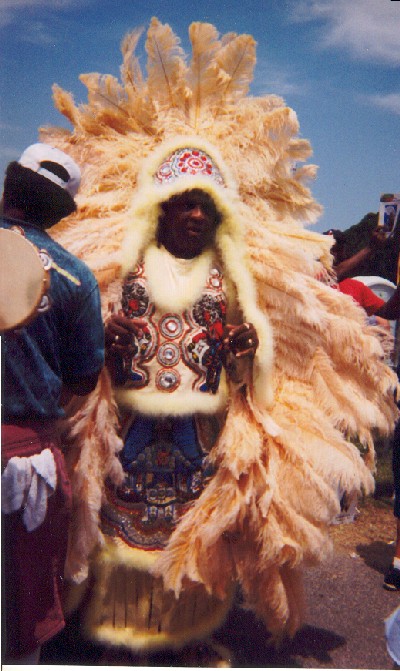MARDI GRAS INDIANS
Tradition and History

Mardi Gras is full of secrets and the Mardi Gras Indians are as much a part of that secret society as any other carnival organization. The Mardi Gras Indians are comprised, in large part, of the blacks of New Orleans' inner cities. They have paraded for well over a century...yet their parade is perhaps the least recognized Mardi Gras tradition.
"TOOK ALL THE PICTURES AT THE" jAZZFEST
Typical Mardi Gras organizations will form a krewe. A krewe often names their parade after a particular mythological hero or Greek god. The ranking structure of a Mardi Gras Krewe is a parody of royalty: King, Queen, Dukes, Knights and Captains...or some variation of that theme.
Few in the ghetto felt they could ever participate in the typical NewOrleans Mardi Gras parade.historically, slavery and racism were at the root of this cultural separation. The black neighborhoods in New Orleans gradually developed their own style of celebrating Mardi Gras. Their Krewes are named for imaginary Indian tribes according to the streets of their ward or gang.
The Mardi Gras Indians named themselves after native Indians to pay them respect for their assistance in escaping the tyranny of slavery. It was often local Indians who accepted slaves into their society when they made a break for freedom. They have never forgotten this support.
In the past, Mardi Gras was a violent day for many Mardi Gras Indians. It was a day often used to settle scores. The police were often unable to intervene due to the general confusion surrounding Mardi Gras events in the city...where the streets were crowded and everyone was masked. This kept many families away from the parade,and created much worry and concern for a mother whose child wanted to join in.

Today when two Mardi Gras Indian tribes pass one another, you will see a living theater of art and culture. Each tribe's style and dress is on display...in a friendly but competitive manner, they compare one another's craftsmanship.
The greeting of the Big Chiefs of two different tribes often starts with a song, chant, ceremonial dance, and threatening challenge to the Big Chief's demand that the other bow and pay respect. The retort is a whoop and equally impressive song and war dance with the reply, Me no Humba, YOU Humba!
Although there was a history of violence, many now choose to keep this celebration friendly. Each Big Chief will eventually stand back and, with a theatrical display of self-confidence, acknowledge the artistry and craftsmanship of the other's suit.

Mardi Gras is no longer a day to settle scores among the Mardi Gras Indians. Violence is a relic of the past. It is now Mardi Gras tradition and practice for the Indians to simply compare their tribal song, dance

and dress with other tribes as they meet that day. Each Indian has invested thousands of hours and dollars in the creation of his suit, and is not willing to risk ruining it in a fight. This tradition, rich with folk art and history, is now appreciated by museums and historical societies around the world. It is a remarkable and welcome change from the past.